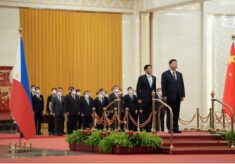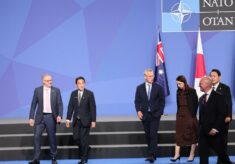The China-USA relationship is the most important short-term global issue that has the potential to detonate a world war, if mismanaged by both sides and the international community. No one is still concretely envisaging a war and everybody will believe that war is a last recourse, but “Vigilia pretium pacis” (Being on watch is the price of peace), paraphrasing SHAPE’s motto.
The Pacific Ocean is the geopolitical pivot of contention, while the rise of China obviously puts into question obsolete global settings. One should not forget that the first practical application of the Indo-Pacific concept was carried out by the Chinese imperial navy (1405-1433) and that, since 1898 (US conquest of the Philippines), the Pacific was the essential strategic theatre for Washington during the whole II WW, a fact confirmed by the unprecedent launch of two nuclear bombs.
Humanity has endured already three world wars (the Cold one was such only for NATO and Warsaw Pact member states) and experience shows that often decision makers fail to estimate probability, length and outcome of the next war. The timely antidote for what will be a civilisation catastrophe is a reasonable course of action looking at short-medium term gains for the US citizens, shared national interests and global interests.
This means that a credible strategy must be based on the tried and tested NATO Harmel method: dialogue and deterrence. While deterrence is practically guaranteed by the evident and vast US military superiority, dialogue is the prerequisite in order to avoid the failure of deterrence due to political miscalculations in both countries (e.g., the perception that the USA are declining or that a quick war can solve the problem of a power rebalance).
Beijing and Washington have all the wherewithal to tone down nationalist rants and pragmatically agree on useful negotiations while allowing a peaceful competition and coexistence for at least five years in order to recover from a turbulent and badly managed relationship.
Interests are at the centre of this China-USA strategy, starting at home. In fact, the long recession that gripped the world has been compounded by the economic ravages of the pandemic: its social and political effects are very visible in the USA. The short and medium-term priority is to rebuild and heal the society by improving the economic conditions of vast sectors, enhancing social rights and welfare, redressing environmental damages, overcoming political and racial antagonism, restarting a sustainable economy and restoring credibility to the decision-making elite. As the history of the last three decades and its present consequences show, this, and not some illusory quest of enduring supremacy, is the main American national interest.
Against all mainstream perceptions, China too has enormous internal problems to be addressed: a deep crisis of ideals among the population; the difficulty in offering a convincing political model to Taiwan; the demographic greying due to the “one child” policy; the still enormous gaps in wealth distribution; a shaky healthcare system and a dangerously polluted environment; the rise of powerful organised criminal groups; a very fragile financial/banking network and a dysfunctional prison system. These are the elements that can lead to a dangerous social and political fragmentation, despite the one-party rule.
Both countries share quite concrete common strategic interests: ending the pandemic at least in the northern hemisphere; galvanising global exchanges and economy; setting up mechanisms of mutual strategic reassurance on vital security interest, while avoiding dangerous confusions between trade and security.
Thirdly, national interest is no more an all-encompassing category in global affairs. Surely it still exists, but the pandemic proves once again the verses of John Donne “Each man’s death diminishes me, For I am involved in mankind. For whom the bell tolls, It tolls for thee.” There is a global common good, overarching national interests, because problems cannot be solved by single countries. A pragmatic list includes at least:
Wider nuclear arms control treaties and enhanced WMD crisis control mechanisms;
Agreements on the peaceful use of space and the restrained use of espionage, interference and offensive means in cyber-space;
Agreements on military uses of AI, starting with limitations on autonomous weapon systems;
Multilateral agreements on macroeconomic stability, climate change and joint climate and renewables research;
Multilateral cooperation on global pandemic management and major diseases.
Thus, the national interests of both countries are rather clear to both leaderships, while those pertaining the global common good are recognised even by thinkers who advocate a change in the top Chinese leadership in favour of a more pragmatic one. The interests shared by both countries are quite concrete and urgent, but often cluttered by the antagonistic heritage of the past four years
Nevertheless, it should be clear that both a new cold war or a “Thucydides trap” vis-à-vis the PRC are unhelpful oversimplifications. Cold War happened in a substantial economic segmentation of economies, while globalisation has created strong interlinkages and its freedom of movement paradigm, albeit imperfect, is a common advantage also for a post-pandemic recovery.
On the other hand, wars are not mechanical traps since they are waged either by necessity (as defensive ones) or by choice (aggressing a country). One country, miscalculating either its fears over national unity interests or overestimating the feasibility of a quick, limited and decisive war, will attack first and decide, after due consideration, the course of a widespread disaster. If the immediate, concrete priority is to rebuild societies, hard-nosed experience shows that fragmented societies are devastated by a war, not consolidated by blood and tears.
Realpolitik is about recognising in time the limits of power and the necessity of structural changes. The Covid-19 pandemic is a global stressor that clearly revealed an untenable global system where single-handed supremacy is unrealistic and unaffordable, global debt has reached more than 355% of the existing GDP, one on three Earth inhabitants is either in misery or hungry and 82% of the global wealth is on the hands of barely 1% of people, if not less. This system does not hold water.
A flexible globalisation, where all major stakeholders are engaged in writing agreed rules, is a sensible way to ensure that vital interests underpin a common sustainable future, avoid very expensive and lethal power competitions and help freeing more people from misery thus helping them to pursue full civil rights. In other words, it is similar to the concert of powers suggested by Richard N. Haass and Charles A. Kupchan recently on Foreign Affairs.
In brief, a credible China strategy is a concrete USA-China strategy to preserve four shared essential interests: repairing the society at home; escape together from escalatory dynamics through dialogue and deterrence; stimulate global sustainable growth, and tackle together and multilaterally five vital global common concerns (nuclear weapons, space/cyberspace, military AI, climate change, pandemics). The rest is dangerous self-delusion.
Alessandro Politi
Director of the NATO Defense College Foundation






























